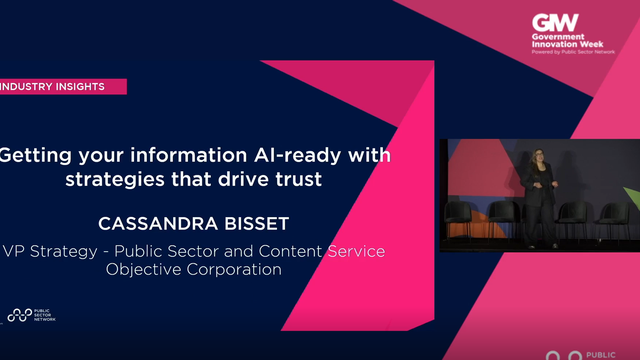Setting the Vision and Developing Your Digital Health Strategy to Create an Interconnected Healthcare System
Spotlight on our Keynote Session with Dr Ted Scott, PhD, MAppSC, CPHIMS-CA, the Vice President of Research and the Chief Innovation Officer at Hamilton Health Sciences
The Healthcare Sector is at a Turning Point
Across much of the healthcare sector worldwide, the global pandemic that many of us are still living through, exposed some of the fault lines that many of the medical professionals have known about for years. The medical sector – like most sectors – is not perfect and is not immune to problems. In fact, many of the larger problems have been festering for a long time, but the sector has been too busy or too blind to address them.
Dr Ted Scott , PhD, MAppSC, CPHIMS-CA, the Vice President of Research and the Chief Innovation Officer at Hamilton Health Sciences, which is an academic research health system located west of Toronto that encompasses specialized and regional hospitals, a trauma center and a cancer center, says that the pandemic has really changed the way the public looks at the health sector. We are now at a critical turning point in healthcare and there is an opportunity for us to rethink how healthcare is delivered.
Though the pandemic has exposed this publically, an institution like Hamilton Health Sciences knew that there were issues many years earlier. In fact, a few years before the pandemic, we undertook a Future of Health Summit.
This came about because we had three assumptions that were based on some challenges:
- That we do not provide access to critical health information which really fundamentally hinders our ability to provide best care
- That even if such information were available, it would not be in the right context or in a timely fashion for patient use; and
- That there was a rising challenge of cost delivery.
The third point was seen as accurate but also kind of ironic. Many procedures, especially in end-of-life cases, were being carried out because of ingrained processes but were probably unnecessary and unwelcome which meant they were also wasteful and also negatively impacted the patient experience, whilst at the same time, we don’t have the funds to provide other services that we need.
Setting a New Vision
Nonetheless, with these three assumptions identified, clinical innovators, researchers, administrative leaders, industry innovators and community patients all came together to discuss these challenges and to come up with a strategy and vision for addressing them. The key point was that there needs to be a greater emphasis on providing care within the context of patients’ homes and communities. The summit also produced three synergistic overlapping priorities:
- Empowering patients – This means giving patients basic information and giving them agency and the ability to make decisions about how care is provided to them.
- Empowering practitioners – Giving practitioners the tools to implement and to change their practice in a timely way.
- Continuous connections – This is the idea that anytime in a care journey, you as the patient would have access to people that understood your condition on a personal level, and have the access to the resources that you need.
Identifying these priorities was the easy part. Implementing them was much more complicated because in almost all care models, the provision of care is very much one directional. The goal of this new vision was to be a disrupter and to create more of a democratic environment where patients are not only having a say, but they’re actually directing the ways in which we provide services to them. Ultimately, it was about creating an interconnected healthcare system, where empowered patients and practitioners drive down costs through efficiency and in turn create a better allocation of services.
Examples of Successful Implementation
Rather than changing the whole system, the best way to implement some of these priorities and to address the challenges, was through the creation of a number of discrete projects. The first of these was a digital transition to care. Following surgery, patients who are able go home early, but are still connected to the hospital through monitoring, and are still supported in their medication and pain management, and educated in terms of how best to return to full vitality. This feeds into the continuous connection priority and is about leveraging a virtual nursing station to liaise with patients and ensuring that the patient is at the center of the recovery context. The patient is also connected to a perioperative physician who can address feedback loops in care through escalations, and thereby in a proactive way, reduce the unnecessary potential emergency visits or even readmissions of care.
A second example is a learning health system that empowers practitioners to better care for their patients. Previously, there was an over subscription to invasive cardiac catheterization procedures. Not only are these procedures expensive, many of them turned out to be unnecessary. So ten years of data was analyzed and though a machine learning model, we’ve created a decision support tool that enables us to better stream patients away from this invasive test to a more appropriate non- invasive test. This algorithm “diverts patients into safer, less expensive approaches to care.
The third example is the creation of an app on a phone to specifically support chronic concussions. These are concussions that affect cognitive functioning and are much longer term challenges. However, though they need to be monitored, they don’t necessarily need to clog up the healthcare system. Thus an app was created for patients to regulate their activity, get feedback on their cognitive load, and through a learning health system approach, they have more of an understanding of what they can safely do and can’t do in terms of their recovery. It’s called ‘MyHead Health’ and is a successful function as part of the clinical treatments.
Changing the System
Each of these examples – and others – will in turn change the system from within. This is because ultimately, each of them is about achieving better outcomes and giving patients the ability to self-manage their care through digital technology enablement and innovation. Each of the examples fits into at least one of the identified priorities, though in most cases there’s a lot of overlap, and this shows the strengths of a digitally enabled strategy.
In fact, having such a digital strategy, with identified priorities and strategies to address the challenges, is really exciting for us. It is about changing the care models by putting the focus back where it really belongs, and by driving the benefits, costs and efficiency. On top of that, having such an approach means you measure things as you go.
“We are really excited about a lot of the enabling components that are in now in our health system. Having this kind of approach allows us to be much more proactive and responsive, and to change things mid stride rather than relying upon lengthy analyses and reporting cycles. We really need to rethink how healthcare is delivered, and we believe we have started that process.”
Dr Ted Scott, PhD, MAppSC, CPHIMS-CA, Vice President, Research & Chief Innovation Officer, Hamilton Health Sciences


































